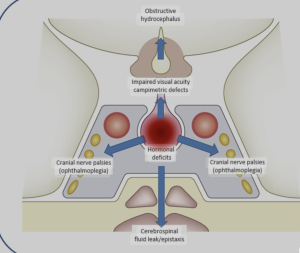In a Systematic Review and Meta-Analysis, Xia et al., from the First College of Clinical Medical Science, Three Gorges University & Yichang Central People’s Hospital, Yichang, Hubei, China, published in Frontiers in Surgery. The authors compared recovery outcomes of neurosurgical vs. conservative treatment in patients with pituitary apoplexy, aiming to provide evidence-based guidance for clinical decision-making.
Recovery from ophthalmoplegia improved wih surgery 3).
The authors claim to provide evidence-based guidance for choosing between surgical and conservative treatment in pituitary apoplexy through a meta-analysis of 33 years of literature.
They conclude that surgery significantly improves ocular muscle paralysis but yields no benefit over conservative management for visual acuity, visual field, or endocrine outcomes.
💣 Critical Issues
1. Methodological Superficiality
Despite claiming a rigorous meta-analysis, the study relies on a fixed-effects model—a questionable choice given the expected heterogeneity across decades of heterogeneous, mostly retrospective, observational studies. This choice artificially narrows confidence intervals and potentially overstates precision. No rationale is given for not using a random-effects model, which is standard in clinical meta-analyses dealing with variable populations and treatment protocols.
2. Garbage In, Garbage Out
The meta-analysis is built on decades of low-quality, non-randomized studies, many of them case series with unclear bias control, inconsistent definitions of “conservative” treatment, and widely varying follow-up times. Combining these into a single pooled analysis under the guise of scientific rigor is like mixing sand with water and calling it wine.
3. Selective Focus on One Endpoint
The only statistically significant result is improved recovery from ocular palsy, a relatively uncommon but visually dramatic symptom. However, this endpoint is cherry-picked from multiple comparisons. The authors fail to correct for multiple testing, raising the possibility of false-positive significance (Type I error). Meanwhile, more clinically impactful outcomes like vision and endocrine function show no benefit from surgery, which the authors conveniently downplay.
4. No Functional or Quality-of-Life Assessment
The study ignores patient-centered outcomes like return to work, quality of life, or long-term disability, which are highly relevant in pituitary apoplexy. This omission renders the analysis clinically superficial and primarily academic.
5. Chinese Academic Inflation
All authors hail from a single academic complex in Yichang, China. While that is not a flaw per se, the lack of international collaboration, external validation, or patient-level data undermines generalizability. Moreover, the article is filled with buzzwords (“evidence-based”, “systematic”) that mask the absence of real clinical insight.
🧨 Bottom Line
This is a meta-analysis in form, not substance. It offers no meaningful advancement in pituitary apoplexy managemet and risks misleading clinicians with overstated conclusions based on underpowered and methodologically fragile data. The statistically significant finding regarding ocular palsy feels more like an artifact of analytic overreach than a real clinical truth.
💬 Suggested Reframing
The study should be read not as a guide, but as a cautionary tale: how a meta-analysis can be used to create a false aura of certainty in an area still in desperate need of high-quality, prospective, controlled studies
Xia K, Peng J, Zhou Y, Liu X, Chen H, Xu H, Wang S, Deng A, Tang H, Hu J. Pituitary apoplexy: surgical or conservative? A meta-analytical insight. Front Surg. 2025 Jun 4;12:1579498. doi: 10.3389/fsurg.2025.1579498. PMID: 40535550; PMCID: PMC12174462.
